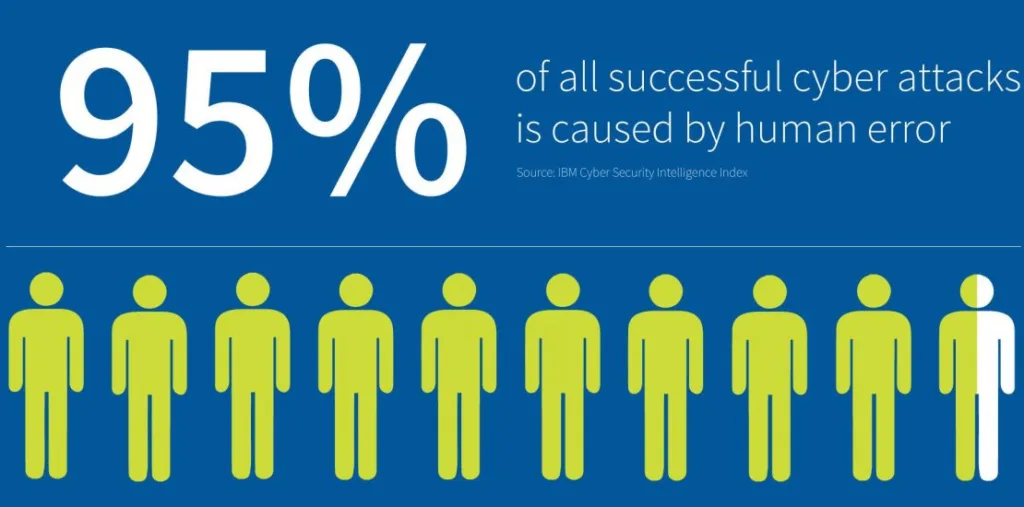In the ever-evolving realm of cybersecurity, where algorithms and firewalls dance with sophisticated threats, it’s easy to overlook the one variable that remains both unpredictable and indispensable – the human factor. Behind every line of code and security protocol, there’s a human touch, and therein lies the intricate dance between security professionals and the individuals they strive to protect.
The Human Quotient: Our Greatest Asset and Challenge
Cybersecurity is often seen as a battle waged in the digital realm, where lines of code clash in a virtual arena. However, it’s crucial to recognize that every line of code has a human author, and every security breach involves a human at some point in the chain. Understanding the human quotient in cybersecurity becomes paramount as we delve into the nuances of this dynamic relationship.
The Weakest Link or the Strongest Ally?

Traditionally, humans have been labeled as the weakest link in the cybersecurity chain. Phishing attacks, social engineering, and simple human error are often the gateways through which cyber adversaries infiltrate systems. However, it’s time to reframe this narrative – humans can also be the strongest allies.
Consider a scenario where an employee, armed with cybersecurity awareness, recognizes a phishing attempt. In that moment, the human factor becomes a formidable defense. Thus, the crux lies not in eradicating the human element but in harnessing its potential as a proactive and vigilant force.
Human Error: A Reality Check
While technology has advanced by leaps and bounds, the fallibility of human nature remains a constant. From inadvertently clicking on a malicious link to unintentionally sharing sensitive information, human errors can be exploited by cybercriminals. However, instead of placing blame solely on individuals, it’s imperative to foster a culture of understanding and continuous learning.
Cultivating a Cybersecurity Mindset
The linchpin of cybersecurity lies in cultivating a cybersecurity mindset among individuals at all levels of an organization. This goes beyond mandatory training sessions and check-the-box exercises; it’s about instilling a genuine understanding of the role each person plays in the security ecosystem.
Imagine a workplace where employees are not just informed about cybersecurity protocols but are actively engaged in discussions, sharing insights, and reporting potential threats. It’s the human factor that can transform a passive cybersecurity stance into an active defense mechanism.
Bridging the Gap: Cybersecurity Education for All
The human factor can only be a strong ally when armed with knowledge. Cybersecurity education is not exclusive to IT professionals; it should be democratized across all departments. From the C-suite to the interns, everyone should be equipped with a foundational understanding of cybersecurity principles.
This education goes beyond the technical jargon; it’s about empowering individuals to make informed decisions. When employees understand the risks and consequences of their actions, they become the first line of defense against cyber threats.
The Human Firewall: Beyond Technology
While firewalls and antivirus software form the technological barricades, the concept of a “human firewall” is gaining prominence. Picture a workforce that is not just security-aware but actively involved in identifying and reporting potential threats. It’s a culture where cybersecurity is everyone’s responsibility, not just the IT department’s.
The Social Engineering Conundrum
Social engineering is the art of manipulating individuals to divulge confidential information. As technology advances, so do the tactics of cyber adversaries. Phishing emails, pretexting, and baiting are just a few examples where the human factor is exploited. Recognizing these tactics is not just a task for cybersecurity professionals but for every individual interacting in the digital space.
Balancing Convenience and Security
In the pursuit of airtight cybersecurity, organizations often implement stringent measures that inadvertently hamper user experience. It’s crucial to strike a balance between security and user convenience. The human factor rebels against cumbersome processes, and finding that equilibrium is key to fostering a security culture that is embraced, not resisted.
Empathy in Cybersecurity: Understanding Human Behavior
Understanding the psychology behind cybersecurity is as vital as understanding the technology. Humans are not machines; they are driven by emotions, habits, and social dynamics. A cybersecurity strategy that acknowledges these nuances is better positioned to resonate with individuals.
The Future of Cybersecurity: A Human-Centric Approach
As we peer into the future of cybersecurity, it’s evident that a human-centric approach is not just a buzzword but a necessity. The landscape will continue to evolve, and cyber threats will grow in sophistication. In this scenario, technology alone cannot bear the burden of defense.
The future demands a paradigm shift where the human factor is not just accommodated but embraced as an integral part of the cybersecurity equation. It’s a future where cybersecurity is not an imposition but a shared responsibility ingrained in the culture of organizations.
The cost of negligence
Neglecting the human factor can result in considerable financial loss, damaged reputation, and loss of customer trust. Sometimes, the damage is irreversible. In the wake of an incident, organizations often realize they could have avoided the breach had they invested in adequate human-centric security measures.
Additionally, starting December 18, 2023, the SEDAR will require public companies to report material cyber incidents within four business days. This will bring greater transparency to investors and customers, and will also shine a spotlight on companies experiencing material breaches.
how Reduce Human-induced Risks
Reducing human-induced risks in cybersecurity requires a multi-faceted approach that encompasses education, technology, and a culture of security awareness. Here are some effective strategies:

1. Comprehensive Cybersecurity Training:
- Regular Training Programs: Implement ongoing cybersecurity training programs for all employees, covering the latest threats, phishing techniques, and best practices.
- Simulated Phishing Exercises: Conduct simulated phishing exercises to test employees’ ability to recognize and respond to phishing attempts. Provide feedback and additional training based on the results.
2. Promote a Security-Aware Culture:
- Leadership Involvement: Encourage leadership to actively promote and participate in cybersecurity initiatives, fostering a culture where security is a top priority.
- Clear Policies and Procedures: Establish and communicate clear cybersecurity policies and procedures. Ensure that employees understand the importance of adhering to these guidelines.
3. User Authentication Best Practices:
- Strong Password Policies: Enforce strong password policies, including regular password updates and the use of complex combinations.
- Multi-Factor Authentication (MFA): Implement MFA to add an extra layer of security and reduce the risk of unauthorized access.
4. Endpoint Security Measures:
- Antivirus and Anti-Malware Solutions: Deploy robust antivirus and anti-malware solutions on all endpoints to detect and mitigate potential threats.
- Device Management: Implement device management policies to ensure that only authorized and properly configured devices can access the network.
5. Data Access Controls:
- Role-Based Access Control (RBAC): Implement RBAC to restrict access to sensitive data based on job roles, ensuring employees have the minimum necessary access rights.
- Regular Access Reviews: Conduct regular reviews of user access privileges to identify and revoke unnecessary permissions.
6. Incident Response Planning:
- Establish Incident Response Teams: Develop and train incident response teams to swiftly and effectively respond to security incidents, minimizing the impact of potential breaches.
- Regular Drills: Conduct regular incident response drills to test the organization’s readiness and identify areas for improvement.
7. Secure Communication Practices:
- Encryption: Encourage the use of encrypted communication channels, especially for sensitive information and data transmission.
- Awareness of Social Engineering: Educate employees on social engineering tactics, such as pretexting and baiting, to reduce the risk of falling victim to such attacks.
8. Continuous Monitoring and Auditing:
- User Activity Monitoring: Implement solutions that monitor user activities and behaviors, identifying any anomalous actions that could indicate a security threat.
- Regular Security Audits: Conduct periodic security audits to assess and address vulnerabilities in the organization’s infrastructure.
9. Collaboration with IT and Security Teams:
- Open Communication Channels: Foster open communication between IT, security teams, and other departments to ensure that potential security concerns are promptly addressed.
- Reporting Mechanisms: Establish easy-to-use reporting mechanisms for employees to report any suspicious activities or security incidents.
10. External Threat Intelligence:
- Stay Informed: Keep abreast of external threat intelligence sources to understand the current threat landscape. Use this information to enhance internal security measures.
11. Vendor Security Assessment:
- Assess Third-Party Security Practices: Evaluate and assess the security practices of third-party vendors to ensure they meet the organization’s cybersecurity standards.
12. Employee Recognition and Rewards:
- Recognition Programs: Implement employee recognition programs for those who consistently demonstrate good cybersecurity practices. This fosters a positive culture around security awareness.
Reducing human-induced risks is an ongoing process that requires a combination of education, technology, and a proactive approach to cybersecurity. By integrating these strategies, organizations can create a resilient defense against the evolving threat landscape.
Conclusion: The Harmonious Symphony of Humans and Technology
In the symphony of cybersecurity, humans are not mere spectators; they are the conductors, orchestrating a harmonious blend of technology and vigilance. Recognizing the importance of the human factor is not a sign of weakness but a testament to our resilience and adaptability.
As we navigate the digital landscape, let’s celebrate the human factor in cybersecurity. Let’s empower individuals to be not just users of technology but guardians of digital realms. Together, humans and technology can create a cybersecurity symphony that resonates with strength, resilience, and shared responsibility.





